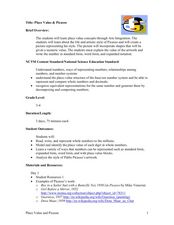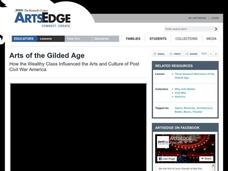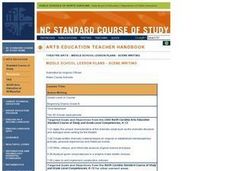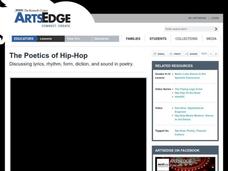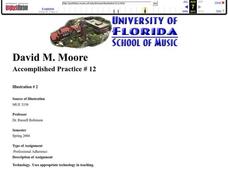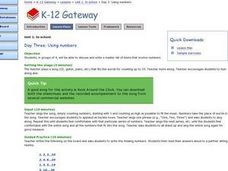Curated OER
Place Value & Picasso
Place value to the millions is the focus of this math lesson. Third and fourth graders investigate multiple ways to represent a number. They examine place value while studying factual information about Pablo Picasso. Resources are provided.
Curated OER
Fractions, Decimals, and Percentages Got You Down? "Tri" This!
Students explore number sense by creating a math presentation in class. In this parts of a whole lesson, students define and discuss the relationship between fractions, decimals and percentages before completing a problem worksheet in...
Curated OER
Arts of the Gilded Age
Students study the art forms of the Gilded Age. In this integrated arts lesson, students research the art, music, dance, and drama of the historical era and then create their own personal projects that exemplify the time period.
Armory Center for the Arts
Place Value Collage
How can art represent math? Use a lesson on place value collages to illustrate the different meanings that numbers have in their designated places. Kids observe photographs and paintings that show place value, then work on their own.
Curated OER
Numbers in Art
Students choose a number from one to twelve and tell a number story about it. They listen to the teacher read "Numbers in Art" by Lucy Micklethwait. Students choose three numbers from one to twelve and view works of art while looking for...
Curated OER
Vegetable Print Patterns
Create a unique print using vegetable stencils and tempera paints applied to grid like pattern formed from cut pieces of paper. Your students will choose either a warm or a cool color scheme.
Curated OER
Can You Compose?
Fourth graders investigate musical notes. In this music activity, 4th graders compose a short song while clapping the rhythm and singing the syllables using the appropriate notes or rests.
Curated OER
Putting It All Together
Students examine a painting. In this shapes and puzzle lesson, students view Guston's painting Blue Water and identify the colors, shapes and recognizable forms. Students work in groups to put together puzzle pieces of the...
Curated OER
Writing in Scientific Notation
Learners discover number sense by completing a math worksheet. In this scientific notation lesson, students identify the purpose for writing in scientific notation and practice writing large numbers in scientific notation. Learners...
Curated OER
A Garden of Verses: Poems About Class Gardens
Students explore botany by participating in a language arts activity. In this garden poetry lesson, students read the classic poem "Mary, Mary Quite Contrary" and discuss the imagery and rhyming methods used. Students examine their own...
Curated OER
Dance, Dance, Dance
Use dance and song to help your charges in adding whole numbers to 10. In this adding to 10 lesson, learners become the manipulatives as you add them.
Curated OER
Scene Writing
Eighth graders create an original scene or short one-act play within specified guidelines. Assessment is based upon the performance of student-created scenes during class time. Rubrics for assessment and connection to state standards...
Curated OER
Starting at the Beginning
Sixth graders develop basic band skills through in-class instruction, individual practice, and the Essential Elements band method. Instruction is teacher-led with examples and drill/practice. National Standards for the arts are...
Curated OER
Master Spy
Students explain that a code is a system of symbols, letters, words, or signals that are used instead of ordinary words and numbers to send messages or to store information. They practice deciphering a variety of secret codes used in...
Curated OER
The Poetics of Hip Hop
High schoolers consider the role of rhythm, form, diction, and sound in poetry. In this integrated arts lesson, students discuss the attributes of poetry as they analyze Shakespearean sonnets, hip hop music lyrics, and poems by...
Curated OER
Emotion Masks
High schoolers analyze and discuss masks of different cultures as an art form to evoke emotion. This instructional activity culminates in the creation of individual mask designs and self-directed assessment (included).
Curated OER
Auroras
In this aurora worksheet, students read a description of an aurora observed by Captain Standard in 1859. Students interpret the description with a drawing giving as much detail as possible using colored media to capture what they read.
Channel Islands Film
Dark Water: Lesson Plan 2 - Grade 3
A discussion of bioluminescence launches an investigation of animal adaptations. After re-watching the opening minutes of Dark Water, class members listen to a reading of What Do You Do with a Tail Like This, and then create a new...
Curated OER
Natural Disasters
Students investigate why natural catastrophes occur around the world and the results of such catastrophes. They investigate how people recover from catastrophes and can they be prevented. Students create their own work of art depicting a...
Curated OER
Music and Technology
Third graders practice reading rhythm patterns with different types of notes and meters. Using a counting system, they perform a sight reading exercise and take notes when needed. They use a form of technology to illustrate the music.
Curated OER
Memorable Singer 1929-1949
Students examine how Louis Armstrong's fame spread from the African American community to the whole world. They examine how his singing style influenced both popular and jazz musicians by participating in guided listening of his musical...
Curated OER
Gateway
Students practice listening to math problems in a foreign language. In this number sentence lesson plan, students listen to the teacher ask them a question in a foreign language that has some type of number combination for an...
Curated OER
Transportation
In this transportation worksheet, students analyze 10 pictures of forms of transportation. Students match these to the words that describe them.
Curated OER
Lesson: Paul Chan: Alternumeric Fonts
Learning to analyze language, symbols, and codes is part of becoming a deep and critical thinker. Young analysts consider their ability to see hidden messages as they analyze the work of Paul Chan. There are two fully developed...
